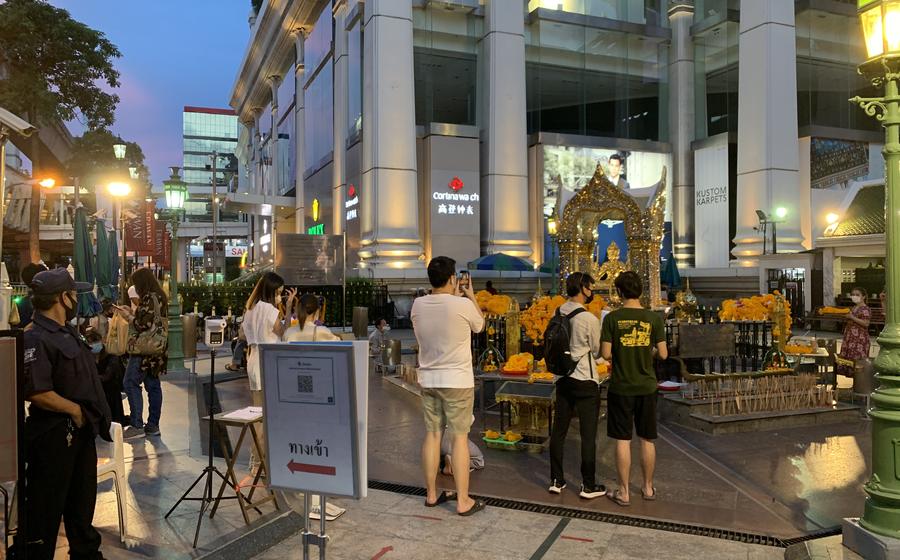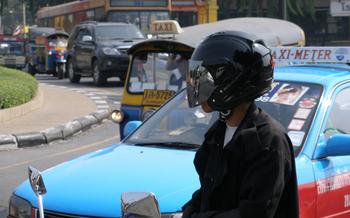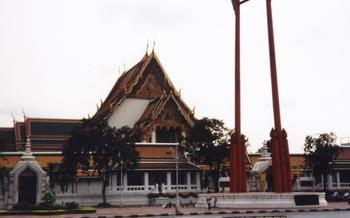
Erawan Shrine
- Erawan Shrine: A Sacred Haven in Bangkok
- The Unique Four-Faced Brahma Statue
- Exploring the Shrine Complex
- Attending Traditional Ceremonies
- Local Beliefs and Superstitions
- Spiritual Significance for Visitors
- Cultural Performances and Events
- Shopping and Dining in the Area
- Combining the Erawan Shrine with Other Attractions
- Respecting Local Customs and Traditions
- Photography and Social Media Etiquette
- Guided Tours and Local Guides
- Insider Tip: Hidden Gems and Secret Spots
Erawan Shrine: A Sacred Haven in Bangkok
Amidst the vibrant tapestry of Bangkok's cityscape, where history intertwines with modernity, lies a sacred haven revered by locals and visitors alike – the Erawan Shrine. This iconic landmark, adorned with intricate spires and shimmering mosaics, stands as a testament to Thailand's deep-rooted spiritual traditions and cultural heritage. Discover the historical significance, religious beliefs and practices, architectural beauty, and cultural importance of this sacred site, a must-visit destination for anyone seeking a profound spiritual encounter in the heart of Bangkok.
-
Historical Significance: The Erawan Shrine was constructed in 1956 as a dedication to Phra Phrom, the Hindu god revered as the creator of the universe. Its origins can be traced back to the construction of a nearby hotel, where unexplained phenomena and accidents prompted the development of a shrine to appease the spirits believed to reside in the area.
-
Religious Beliefs and Practices: The Erawan Shrine is a place of worship and devotion for followers of Buddhism and Hinduism, who come to pay homage to Phra Phrom and seek blessings for various aspects of their lives. Visitors can witness the vibrant rituals and offerings made to the deity, including the enchanting dance performances dedicated to Phra Phrom.
-
Architectural Beauty: The Erawan Shrine captivates visitors with its stunning architectural design, showcasing a blend of traditional Thai and Hindu elements. Its central feature is the towering four-faced Brahma statue, surrounded by smaller shrines dedicated to other deities and mythical creatures. The intricate carvings, colorful murals, and glistening spires create a mesmerizing visual spectacle.
-
Cultural Importance: The Erawan Shrine holds immense cultural significance in Thailand, serving as a symbol of national pride and cultural heritage. It is a place where locals and tourists alike come to pay their respects, seek blessings, and express their gratitude for answered prayers. The shrine's popularity has also transformed it into a prominent tourist attraction, drawing visitors from around the world who come to experience the unique blend of spirituality and cultural immersion.
The Unique Four-Faced Brahma Statue
At the heart of the Erawan Shrine stands the awe-inspiring four-faced Brahma statue, a mesmerizing representation of the Hindu god of creation. Each face, adorned with intricate details and symbolism, holds a profound significance in Thai culture and beliefs.
The eastern face, representing compassion and benevolence, gazes towards the rising sun, symbolizing new beginnings and hope. The southern face, associated with protection and justice, faces the direction of Yama, the Hindu god of death, warding off evil spirits and negative energies. The western face, embodying love and passion, looks towards the setting sun, representing the cyclical nature of life and relationships. And finally, the northern face, symbolizing wealth and prosperity, gazes towards the direction of Kubera, the Hindu god of wealth, inviting abundance and good fortune.
Legends and myths surround this enigmatic statue. One tale speaks of a group of Thai merchants who, while traveling to China, encountered a violent storm that threatened to sink their ship. In desperation, they prayed to Brahma, promising to build a shrine in his honor if they survived. Miraculously, the storm subsided, and upon their safe return to Thailand, they fulfilled their vow by constructing the Erawan Shrine.
Devotees from all walks of life flock to the shrine to offer prayers and make offerings to the four-faced Brahma. They seek blessings for success in business, good health, harmonious relationships, and protection from harm. The statue has become a symbol of hope and a source of comfort for many Thais, who believe in its power to grant their wishes and bestow good fortune upon them.
Exploring the Shrine Complex
The Erawan Shrine complex encompasses more than just the main shrine dedicated to the four-faced Brahma. As you explore the grounds, you'll discover a labyrinth of smaller shrines, each with its unique charm and significance. There are shrines dedicated to various deities, including Vishnu, Shiva, and Indra, as well as a shrine to the Hindu elephant god, Ganesha.
Amidst the shrines, you'll find serene gardens adorned with colorful flowers, cascading waterfalls, and intricate sculptures. Take a moment to stroll through these gardens, allowing the tranquility of the surroundings to wash over you. The gardens offer a respite from the bustling city, providing a peaceful oasis for reflection and contemplation.
Don't miss the impressive elephant statues that guard the entrance to the main shrine. These majestic creatures, intricately carved from stone, symbolize strength, wisdom, and loyalty. Visitors often stop to pay their respects and make offerings to the elephants, seeking their blessings for good fortune and protection.
The Erawan Shrine is also home to numerous wishing bells. These bells, adorned with colorful ribbons, hang from the eaves of the shrines and throughout the complex. Visitors can purchase a bell, write their wishes on the attached ribbon, and then ring the bell to send their wishes up to the heavens. The sound of the bells tinkling in the breeze creates a magical atmosphere that adds to the shrine's spiritual allure.
When taking photos or videos at the Erawan Shrine, be mindful of other visitors and avoid disruptive behavior. The shrine is a place of worship, and it's important to respect the sanctity of the site.
Attending Traditional Ceremonies
The Erawan Shrine is not just a place of worship but also a venue for traditional Thai ceremonies and special events. These ceremonies are a sight to behold, showcasing the rich cultural and religious heritage of Thailand.
The most important ceremony is the daily Brahma Puja, held twice a day, in the morning and evening. During the ceremony, monks chant prayers and perform rituals to honor the four-faced Brahma. The ceremony is accompanied by traditional Thai music and dance, creating a mesmerizing atmosphere.
Other special events include the Erawan Shrine Annual Festival, held in November, and the Songkran Festival in April. These festivals are a time of great celebration and merriments, attracting both locals and tourists alike. During these festivals, the shrine is adorned with colorful decorations, and there are processions, performances, and food stalls.
Visitors are welcome to attend these ceremonies and festivals. It is a unique opportunity to immerse yourself in Thai culture and witness the deep devotion of the Thai people. If you are lucky, you may even be invited to participate in some of the rituals, such as offering flowers or incense to the deity.
Local Beliefs and Superstitions
Locals and visitors alike hold strong beliefs and superstitions associated with the Erawan Shrine. Many believe that the shrine possesses a powerful spiritual energy that can grant wishes and bring good fortune. Stories abound of miracles and answered prayers, further fueling the shrine's reputation as a sacred place. Some visitors even make a point of visiting the shrine on special occasions or during important life events, seeking blessings and protection. The shrine's popularity has also led to the emergence of various rituals and practices, such as circumambulating the main shrine three times or offering specific types of food to the deity. These practices are believed to bring good luck, ward off evil spirits, or fulfill one's desires. The Erawan Shrine has become deeply intertwined with local beliefs and superstitions, making it a significant cultural and spiritual site in Bangkok.
Spiritual Significance for Visitors
The Erawan Shrine holds immense spiritual significance for visitors from diverse backgrounds and religions. It transcends religious boundaries, attracting people who seek solace, guidance, and a connection with the divine. Many visitors find a sense of peace and tranquility within the shrine's serene atmosphere, amidst the bustling city. The shrine's reputation as a place of power and good fortune further enhances its spiritual allure.
For those who believe in the power of prayer, the shrine offers a sacred space to make wishes and seek blessings. The four-faced Brahma statue is believed to be particularly receptive to prayers, and offerings made to the deity are said to bring good luck and prosperity. Visitors often light incense sticks and candles, make offerings of flowers and food, and pray with deep devotion.
The shrine also provides an opportunity for visitors to explore their own spiritual beliefs and practices. While some may come with specific prayers or requests, others find the shrine to be a place of contemplation and self-reflection. The tranquil ambiance and the presence of religious iconography can inspire a sense of spirituality and connection to a higher power.
Whether visitors come to pray, make offerings, or simply seek a moment of peace and reflection, the Erawan Shrine offers a unique and deeply personal spiritual experience. It is a place where people from all walks of life can find solace, guidance, and a connection to the divine.
Cultural Performances and Events
The Erawan Shrine is not just a place of worship but also a vibrant cultural hub. Throughout the year, the shrine hosts a variety of traditional performances and events that showcase the rich artistic heritage of Thailand. These performances add a lively and festive atmosphere to the shrine, making it a great place to experience the country's vibrant culture.
The most popular performances are the Thai classical dance and music shows. These shows typically feature graceful dancers adorned in elaborate costumes, accompanied by musicians playing traditional instruments. The dances are often based on ancient stories and legends, providing a glimpse into Thailand's rich history and mythology.
Performances usually take place on weekends and holidays, and the schedule can be found on the shrine's official website or by asking at the information counter. Visitors are advised to arrive early to secure a good seat, as the shows are often very popular.
Attending a cultural performance at the Erawan Shrine is a wonderful way to immerse yourself in the beauty and diversity of Thai culture. Whether you are a lover of dance, music, or simply want to experience something truly unique, these performances are not to be missed.
Shopping and Dining in the Area
The Erawan Shrine is surrounded by a vibrant neighborhood offering a range of shopping and dining options. From traditional markets to modern shopping malls, visitors can find everything they need within easy reach of the shrine.
For those seeking souvenirs and religious items, the nearby market stalls sell a variety of offerings, including Buddha statues, amulets, and incense. Local handicrafts and handmade souvenirs are also available, providing a unique opportunity to support local artisans and take home a piece of Thailand's rich culture.
When it comes to dining, the area around the Erawan Shrine is a culinary paradise. From street food stalls to upscale restaurants, there are options to suit every taste and budget. Visitors can savor the flavors of authentic Thai cuisine, including popular dishes like pad thai, tom yum soup, and mango sticky rice.
To make the most of your visit, consider combining your pilgrimage to the Erawan Shrine with a shopping and dining adventure. Explore the local markets, sample the delicious street food, and indulge in a memorable meal at one of the nearby restaurants. By embracing the vibrant atmosphere and immersing yourself in the local culture, you'll create a truly unforgettable experience.
Combining the Erawan Shrine with Other Attractions
The Erawan Shrine is situated in the heart of Bangkok, surrounded by a plethora of other attractions that offer a diverse range of experiences. Once you have paid your respects and explored the shrine, why not venture out and discover the surrounding area?
For a comprehensive cultural immersion, combine your visit to the Erawan Shrine with a trip to the nearby Grand Palace. This iconic landmark is the official residence of the Thai royal family and features stunning architecture, intricate murals, and sacred temples. Marvel at the grandeur of the Emerald Buddha, considered the most sacred Buddha image in Thailand, and learn about the country's rich history and monarchy.
If you are fascinated by Thai art and culture, a visit to the Bangkok National Museum is a must. This extensive museum houses a vast collection of artifacts, from ancient sculptures and paintings to traditional costumes and musical instruments. Immerse yourself in the vibrant history and diverse cultural heritage of Thailand through its captivating exhibits.
For a more modern and lively experience, head to the MBK Center, one of Bangkok's largest shopping malls. This sprawling complex offers a mix of international and local brands, catering to every taste and budget. Indulge in retail therapy, grab a bite to eat at one of the many restaurants, or catch a movie at the cinema.
To delve deeper into the local way of life, explore the vibrant Chatuchak Weekend Market. This bustling bazaar is a paradise for shoppers, with thousands of stalls selling everything from clothing and accessories to souvenirs and handicrafts. Experience the vibrant atmosphere, savor delicious street food, and immerse yourself in the vibrant energy of this iconic market.
These are just a few of the many attractions that await you in Bangkok. With its rich cultural heritage, vibrant street life, and endless possibilities for exploration, the city offers a truly unforgettable experience.
Respecting Local Customs and Traditions
When visiting the Erawan Shrine, it is essential to be mindful of local customs and traditions to show respect for the sacred site and its religious significance. Visitors should dress appropriately, avoiding revealing or overly casual attire. Shorts, tank tops, and flip-flops are generally not considered appropriate for visiting the shrine. It is also important to avoid loud or disruptive behavior, as the shrine is a place of worship and tranquility.
When entering the shrine, visitors should remove their shoes and place them in the designated racks or cubbies. It is customary to bow or wai (a traditional Thai greeting) towards the shrine as a sign of respect. When making offerings, visitors should approach the shrine with reverence and follow the proper etiquette. It is considered disrespectful to touch or lean on the statues or other sacred objects.
It is also important to be mindful of local customs and beliefs related to the shrine. For example, some visitors believe that it is bad luck to step on the threshold of the shrine or to whistle while inside the complex. While these beliefs may seem strange or superstitious to some, it is important to respect them as part of the local culture.
By following these guidelines and showing respect for local customs and traditions, visitors can help to preserve the sacredness of the Erawan Shrine and ensure a positive and meaningful experience for all.
Photography and Social Media Etiquette
When visiting the Erawan Shrine, it is important to be mindful of the sacred nature of the site and to respect the privacy of other visitors. Photography and videography are permitted, but it is essential to do so in a respectful manner. Avoid using flash photography, as it can be disruptive to both the shrine's atmosphere and the people around you.
When taking photos or videos, be sure to focus on the shrine itself and the surrounding area, rather than on individual visitors. If you wish to take photos of people, always ask for their permission first. It is also important to be aware of your surroundings and to avoid blocking the path of other visitors or disrupting ceremonies or rituals.
When sharing your photos or videos on social media, be sure to tag the shrine's official accounts and use relevant hashtags. This will help to promote the shrine and allow others to discover this sacred place. However, avoid posting any photos or videos that may be considered disrespectful or offensive. Always remember that the Erawan Shrine is a place of worship and that your actions should reflect the reverence and respect that the site deserves.
Guided Tours and Local Guides
If you want to delve deeper into the history, legends, and rituals associated with the Erawan Shrine, consider booking a guided tour. Local guides can provide insightful commentary, explain the significance of various offerings, and help you navigate the complex properly. Look for reputable tour operators that offer small group tours or private experiences. They can customize the tour to your interests and ensure a personalized experience. Guided tours are a great way to gain a deeper understanding of the shrine's cultural and religious significance.
Insider Tip: Hidden Gems and Secret Spots
Beyond the main shrine and the popular areas, the Erawan Shrine complex holds hidden gems and secret spots that offer tranquility and unique perspectives. One such spot is the small garden located behind the main shrine, featuring a serene pond, lush greenery, and intricate sculptures. Take a moment to sit by the pond, enjoy the peaceful ambiance, and appreciate the intricate details of the shrine's architecture.
Another hidden gem is the rooftop terrace, accessible via a narrow staircase near the main shrine. From here, you can enjoy panoramic views of the city skyline and the surrounding neighborhoods, offering a different perspective of Bangkok.
To escape the crowds and find moments of solitude, head to the smaller shrines dedicated to various deities within the complex. These shrines are often quieter and offer a more intimate experience. Take your time to explore these lesser-known areas and discover the hidden beauty and spiritual significance of the Erawan Shrine.


